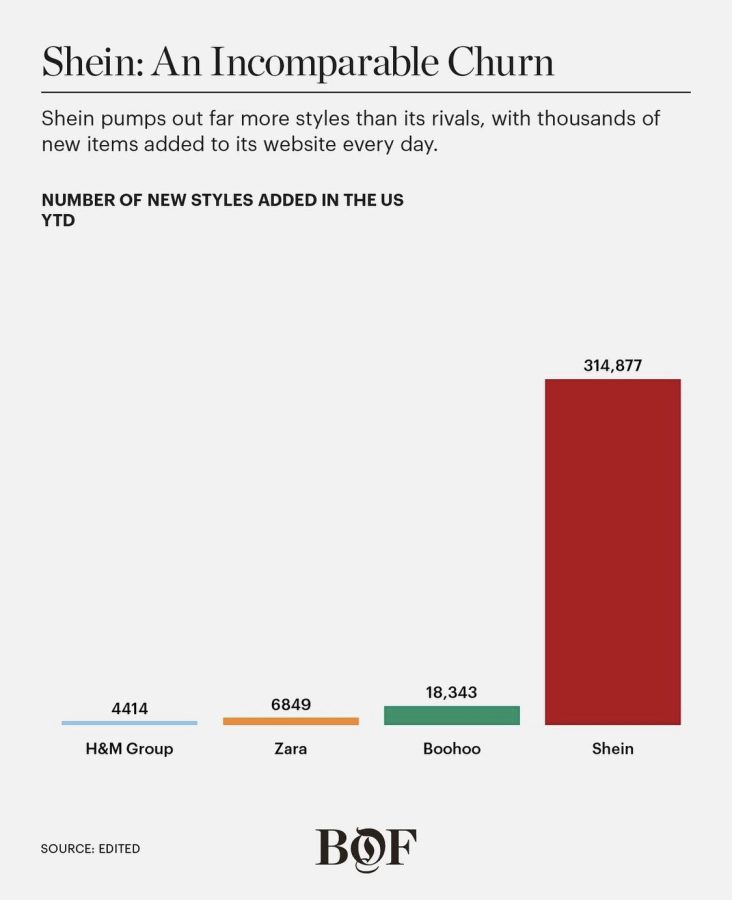A Costly Bargain
April 20, 2022
Spring has officially sprung, and along with the blossoming flowers and trees, the runways and catwalks are also sprouting with new fashions galore. But the climate in which these styles thrive is markedly different from the past.
Gone are the days when fashionable items were only accessible to the rich and elite who could pay designer prices; now, shoppers can find trendy clothing from a large variety of fast fashion sites for remarkably low costs.
But a deeper dive into the practices these retailers employ reveals that there are hidden costs among almost every too-good-to-be-true price tag.
To begin with, textile production is an incredibly water and energy-intensive process.
It takes more than 700 gallons of water to make a single cotton t-shirt and around 2,000 gallons of water to make a typical pair of jeans, enough drinking water on average to sustain a person for nearly 11 years.
According to a UN press release, the fashion industry is the second-biggest consumer of water and is responsible for 8-10% of global carbon emissions—more than international flights and maritime shipping combined. Textile Exchange’s 2010 Global Market Report On Sustainable Textiles estimated that one trillion kilowatt-hours were used to manufacture textiles.
Fast fashion also utilizes open-loop production cycles, which means that the water from production facilities is not cleaned and reused like in a closed-loop system; instead, the polluted water is dumped directly into the environment, polluting land and waterways with toxic chemicals and metals.
The environmental impact of clothing extends way beyond production. The problem spans from conception to destruction and boils down to one theme: waste.
85% of clothing purchased by Americans ends up in landfills. Most large clothing retailers primarily use synthetic materials in their clothing like polyester, which is essentially plastic that will not decompose and perpetuates fossil fuel extraction. The fashion industry is responsible for about 20-35% of the microplastics in the ocean.
Fast fashion exacerbates these issues by the sheer amount and speed of textile production the industry utilizes, as its business model is fundamentally trend centered and consumer-driven, delivering both style and affordability to customers.
As comedian Hasan Minhaj puts it in a fast fashion-centered episode of his Netflix series, The Patriot Act, “Fast fashion is popular because it’s democratized high fashion, and they do that by knocking off designer brands at scale.”
Minhaj further explains in the segment that fast fashion companies synthesize two distinct methods to maximize their domination in the market: quick response manufacturing and dynamic assortment. The former refers to the strategy of cutting lead times at all stages of the production process in order to move product to the market as quickly as possible, hence the “fast” portion of fast fashion.
Zara can launch a product, from drawing board to storefront, in a matter of three weeks. SHEIN takes it a step further, launching in as little as three days (compare that to a normal lead time of around nine months.)

The second method, dynamic assortment, is the process of frequently changing store offerings to increase site traffic—as much as daily as opposed to the traditional few times annually. Companies are pushing new launch after launch, modeling the rapidity of their production process with that of consumer trends and demand.
The pioneers of this business model include fast fashion giants Zara and H&M, valued at $14.7 billion and $40.9 billion respectively.
The issue becomes a vicious, self-perpetuating cycle in that because the clothing is cheaply made, it is unlikely to last long and more likely to quickly be discarded. Additionally, studies of consumer habits show the low price point renders the clothing more disposable in the buyer’s mind.
In addition to the environmental detriment, the human cost of fast fashion clothing is lofty and potentially deadly. Garment workers in majority world countries earn poverty-level wages, sometimes as low as three cents an hour. The only way companies can afford to charge so little for their items is by drastically cutting labor costs.
Working in clothing factories also poses numerous occupational hazards. Workers have prolonged exposure to chemicals and synthetic dyes that can cause lung disease, reproductive risks, and even cancer. The factories themselves can also be dangerous due to lack of domestic regulation, as seen by numerous instances of disaster.
One that comes to mind is the infamous 2013 Rana Plaza factory collapse in Bangladesh, which killed 1,129 workers and injured many others. The incident demonstrates that the harrowing, Triangle Shirtwaist factory-reminiscent working conditions that have been regulated away in the West have not been eliminated, just outsourced overseas.
Psychology may explain why despite the overwhelming (and relatively well-publicized) incriminating evidence, fast fashion remains a booming sector. Unfortunately, it is human nature to be more emotionally detached from workers thousands of miles away. Even if we’re aware that they exist, it remains difficult for us to imagine their realities, so it’s easy to compartmentalize or block them out in favor of that serotonin rush from hitting “Place Order.”
But if there is one lesson about economics to be learned, it is that nothing is really free—there is always an opportunity cost associated with everything. Someone has to pay the price, and if it isn’t consumers, it is the workers or the environment.